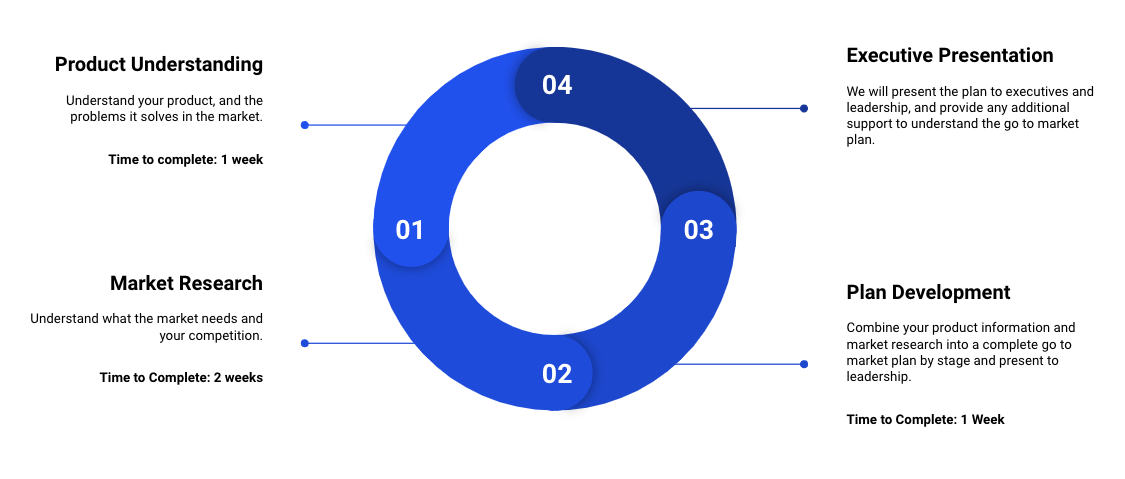Go to Market Strategy and Plans
We can develop a full go to market strategy and plan to bring your Software as a Service (SaaS) products to life.
In the fast-paced and ever-evolving landscape of business, having a stellar product or service alone isn’t enough to guarantee success. The real challenge lies in effectively bringing that product or service to market – and that’s where a well-thought-out go-to-market (GTM) strategy comes into play.
At its core, a go-to-market strategy is more than just a roadmap; it’s a carefully crafted plan that encompasses every aspect of introducing, promoting, and selling your offering to your target audience. It’s about understanding your market, knowing your audience, and executing with precision and agility. Here, we delve into the essence of crafting an effective GTM strategy:
Understanding Your Market: Before embarking on any go-to-market initiative, it’s imperative to have a deep understanding of your market landscape. Who are your competitors? What are the prevailing trends? Where do the opportunities lie? Conduct thorough market research to uncover insights that will inform your strategy and set you apart from the crowd.
Knowing Your Audience: Next, get to know your audience inside out. What are their pain points? What solutions are they seeking? How do they prefer to consume information? Develop detailed buyer personas to tailor your messaging and approach to resonate with your target audience on a personal level. Remember, it’s not just about selling a product – it’s about solving a problem for your customers.
Crafting Your Value Proposition: With a clear understanding of your market and audience, it’s time to craft a compelling value proposition that sets you apart from the competition. What makes your offering unique? How does it address the specific needs and desires of your target audience? Your value proposition should be concise, clear, and communicated consistently across all touchpoints.
Choosing the Right Channels: Once you’ve defined your value proposition, it’s crucial to select the most effective channels to reach your audience. Whether it’s through digital marketing, social media, content marketing, or traditional advertising, choose channels that align with your audience’s preferences and behaviors. And don’t forget the power of partnerships and collaborations to extend your reach even further.
Executing with Precision: With your strategy in place, it’s time to put your plan into action. Execute with precision and attention to detail, ensuring that every aspect of your go-to-market initiative is aligned with your overall objectives. Track your progress, measure your results, and be prepared to adapt and iterate based on real-time feedback and insights.
About this Process
We create a comprehensive go to market plan to ensure you have a complete understanding of taking your product to market. All said, our comprehensive and efficient process is fast, easy, and accurate.
From start to finish, you will have a go to market strategy for your products in 4 weeks.

Go to Market Strategy Plan
- Product research and understanding of your product including features, benefits, and fit for the market.
- Market research, including needs and pain points and competitor research.
- Development of voice and messaging.
- Production of a full go to market plan covering collateral and advertising strategy.
- Sales enablement plan, including necessary training and identification of lead generation activities.
- Executive report-out and presentation
F.A.Q.
Here are a few of the most common question we are asked. Not seeing an answer? Please reach out – we are happy to help!
What is your fee?
We charge one up front and simple fee of $3000 to develop your go to market plan for a single product. Additional products are each $3000.
How long does it take?
We have created and efficient process to create your one of a kind strategy, and it takes roughly 1 month to complete.
How Do You Define the Target Market for a Product?
Identifying the target market involves analyzing demographics, psychographics, and behavioral characteristics of potential customers who are most likely to benefit from and purchase the product. Market research, customer surveys, and data analysis are commonly used to define the target market.
How Do You Develop a Compelling Value Proposition?
A compelling value proposition articulates the unique benefits and value that a product or service offers to its target audience. It should address the specific needs, pain points, and desires of customers and differentiate the product from competitors. Value proposition development often involves customer research, market analysis, and messaging refinement.
What Metrics Should You Track to Measure Product Marketing Success?
Key performance indicators (KPIs) for product marketing may include metrics such as sales revenue, customer acquisition cost (CAC), customer lifetime value (CLV), market share, customer satisfaction, brand awareness, and conversion rates. Tracking these metrics helps assess the effectiveness of marketing efforts and identify areas for improvement.
